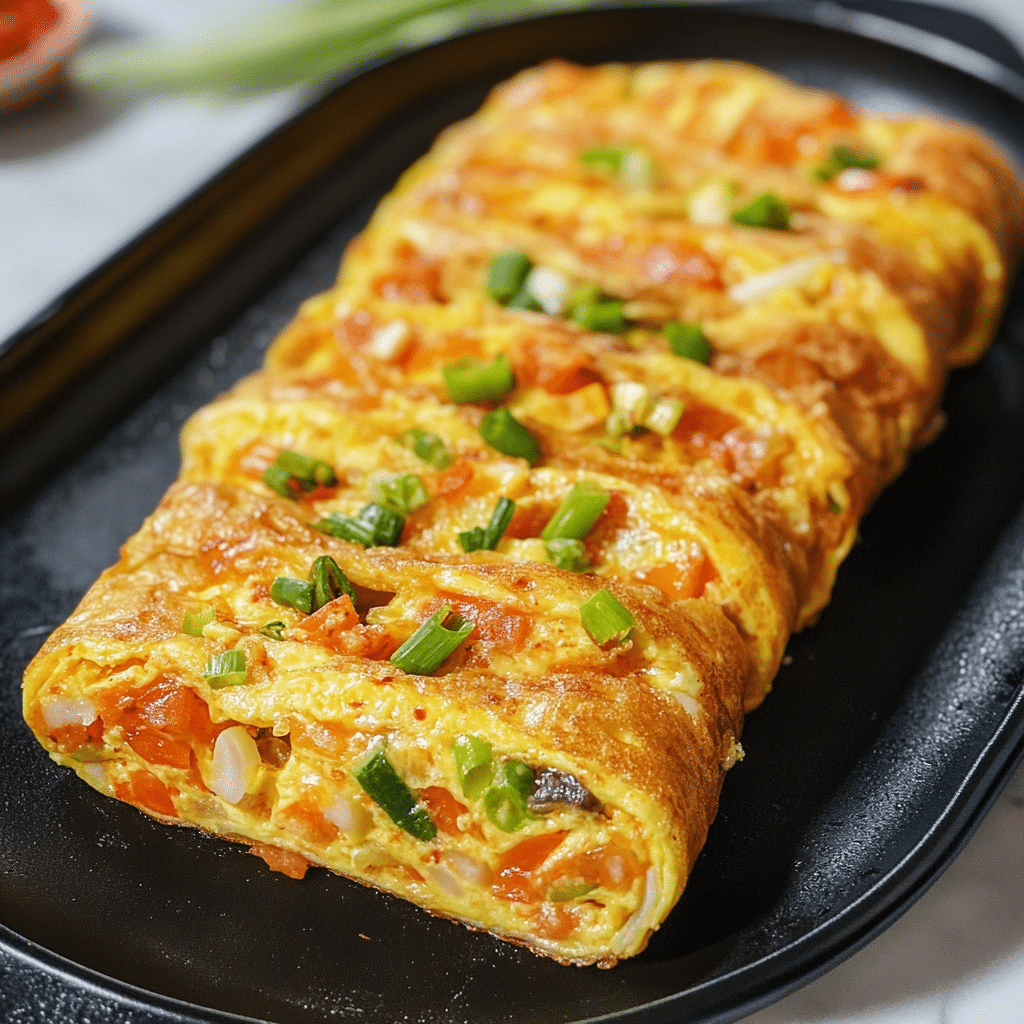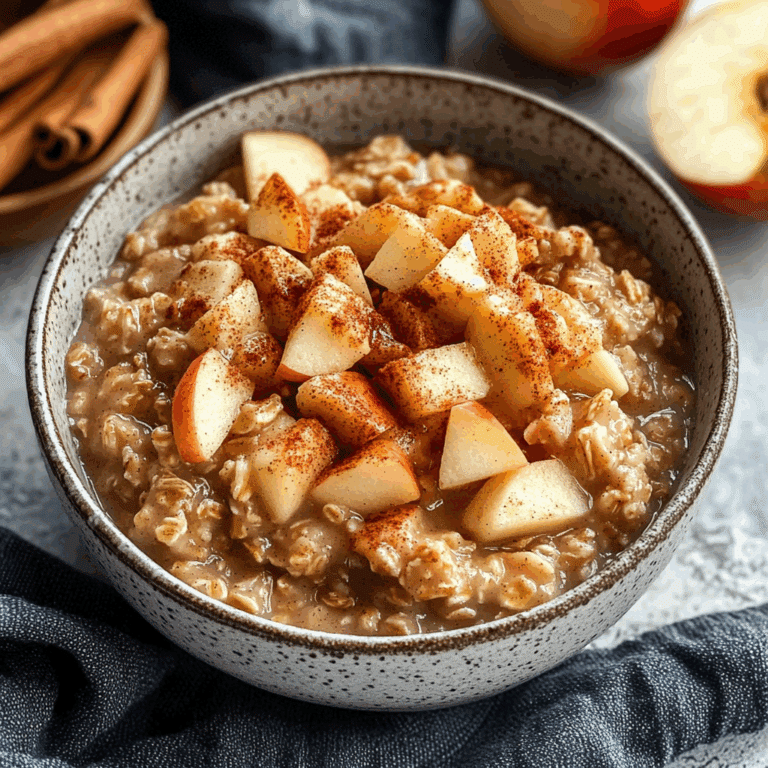How to Make Korean Rolled Omelette Easily

If you’ve ever wanted to master a simple yet delicious dish that brightens your breakfast plate or snack time, then you’re in for a treat. The Korean Rolled Omelette is a fluffy, flavorful staple that is as satisfying to eat as it is fun to make. This dish features tender layers of egg gently rolled to create a beautiful, melt-in-your-mouth texture, making every bite a delight. Whether you’re a kitchen beginner or a seasoned cook, this recipe will show you exactly how to whip up a Korean Rolled Omelette effortlessly, with ingredients you likely have on hand. Let’s dive right in and bring that savory goodness to your table!
Why You’ll Love This Recipe
- Simple ingredients: Uses everyday kitchen staples, making it easy to prepare anytime.
- Quick cooking: Ready in under 15 minutes, perfect for busy mornings or snacks.
- Fluffy texture: The egg layers create a soft, airy bite that’s incredibly satisfying.
- Versatile dish: Great as a side, main, or snack with endless customization options.
- Kid-friendly: Mild, tasty flavors that appeal to all ages.
Ingredients You’ll Need
These simple but essential ingredients come together to create the perfect combination of taste, texture, and color that defines the Korean Rolled Omelette. Each element plays a crucial role in achieving the ideal fluffiness and rich flavor.
- Eggs: The star ingredient, providing the base for the fluffy layers.
- Salt: Enhances the natural flavor of the eggs without overpowering.
- Sugar: Adds a hint of sweetness to balance savory notes.
- Green onions: Offer a mild onion flavor and vibrant green color.
- Vegetable oil: Prevents sticking and helps achieve a golden-brown finish.
- Optional: Carrot or bell pepper: These add sweetness and a pop of color if you want extra nutrients.
Variations for Korean Rolled Omelette
Feel free to make this Korean Rolled Omelette truly your own! This recipe easily adapts to dietary needs, available ingredients, and your favorite flavors, adding excitement to a classic dish.
- Cheese twist: Fold in shredded cheese between layers for a creamy, gooey surprise.
- Spicy kick: Add finely chopped chili or a dash of gochujang to spice things up.
- Herbs and greens: Incorporate spinach, parsley, or chives for fresh herbal notes.
- Seafood boost: Mix in small cooked shrimp or crab for a protein-rich option.
- Vegan style: Use chickpea flour batter and nutritional yeast for an eggless version with similar texture.

How to Make Korean Rolled Omelette
Step 1: Whisk the eggs thoroughly
Crack the eggs into a bowl, then add salt, sugar, and finely chopped green onions. Whisk everything together until the mixture is uniform and slightly frothy, which helps create that fluffy texture.
Step 2: Heat the pan and oil
Place a non-stick pan or a rectangular tamagoyaki pan over medium heat. Add a small amount of vegetable oil and spread it evenly with a paper towel; this step prevents sticking and promotes even cooking.
Step 3: Pour a thin layer of egg mixture
Pour just enough egg mixture to cover the bottom of the pan thinly. Let it cook for about 30 seconds until it’s partially set but still slightly runny on top — this ensures the layers stick together when rolled.
Step 4: Roll the first layer
Using a spatula or chopsticks, gently roll the egg layer toward the far edge of the pan.
Step 5: Apply more egg and roll again
Move the rolled egg back to the near side of the pan. Add another thin layer of egg mixture under the roll, allowing it to spread beneath. Once partially set, roll the entire mass again toward the far edge.
Step 6: Repeat layering and rolling
Continue this process until all the egg mixture is used. Each roll builds fluffy layers, creating a beautifully layered omelette.
Step 7: Shape and rest
Once done, gently press the omelette to shape it evenly, then transfer it to a cutting board and let it rest briefly before slicing for the best texture.
Pro Tips for Making Korean Rolled Omelette
- Use medium-low heat: Cooking slowly prevents browning too quickly and helps layers form smoothly.
- Thin layers are key: Pour less egg per layer to make rolling easier and achieve perfect fluffiness.
- Invest in a rectangular pan: Ideal for shaping and rolling the omelette evenly, though a round pan works too.
- Don’t overcook: Slightly undercooked centers mean moist and tender bite, avoiding dryness.
- Prep chopped veggies finely: This ensures they cook quickly and blend seamlessly into the texture.
How to Serve Korean Rolled Omelette
Garnishes
Sprinkle finely chopped green onions, toasted sesame seeds, or a drizzle of soy sauce to enhance presentation and flavor. These small touches elevate both taste and appearance.
Side Dishes
Pair your Korean Rolled Omelette with steamed rice, kimchi, or a light salad to balance the meal with variety and textures.
Creative Ways to Present
Slice the omelette into even bite-sized pieces and arrange them on a platter for sharing, or serve stacked with dipping sauces like soy or spicy mayo for a modern twist.
Make Ahead and Storage
Storing Leftovers
Keep leftover Korean Rolled Omelette in an airtight container in the refrigerator for up to 2 days to maintain firmness and flavor.
Freezing
Wrap tightly in plastic wrap and place in a freezer-safe bag. Frozen omelette can last up to one month and is great for convenient meal prep.
Reheating
Reheat gently in a microwave or on low heat in a pan to preserve moisture and avoid toughness, restoring that soft, fluffy texture.
FAQs
What pan is best for making Korean Rolled Omelette?
A rectangular or square non-stick pan is traditionally used to make the rolling easier and achieve even layers, though a round pan can also work with practice.
Can I add vegetables to the Korean Rolled Omelette?
Absolutely! Finely chopped vegetables like carrots, bell peppers, or spinach can be mixed in for added color, flavor, and nutrition without affecting the rolling process.
Is it necessary to use sugar in the recipe?
Sugar is used to balance the flavors with a slight sweetness typical in this Korean dish, but you can reduce or omit it according to your taste preferences.
How do I prevent the egg from sticking to the pan?
Using a good amount of vegetable oil and a non-stick pan, as well as controlling heat to medium-low, helps prevent sticking and makes rolling smoother.
Can I prepare Korean Rolled Omelette for meal prep?
Yes, it stores well and is perfect for make-ahead breakfasts or snacks. Reheat gently to maintain texture and enjoy it anytime.
Final Thoughts
Making Korean Rolled Omelette is a rewarding experience that delivers a tasty, fluffy delight perfect for any time of day. With simple ingredients and easy steps, you can add a touch of Korean flavor and flair to your kitchen repertoire. Give this recipe a try and watch it become your go-to breakfast or snack favorite in no time!
Related Posts
- 5 Must-Try Stuffed Bagels for Breakfast
- How to Make Sticky Buns with Caramelized Pecans
- Why Strawberry Croissant Sandwich Is Perfect Breakfast

Korean Rolled Omelette
- Total Time: 15 minutes
- Yield: 2-3 servings 1x
- Diet: Gluten Free
Description
The Korean Rolled Omelette is a simple, fluffy, and flavorful dish perfect for breakfast or snacks. Made with everyday ingredients, this rolled egg omelette provides tender layers and a melt-in-your-mouth texture. It’s quick to prepare, kid-friendly, and versatile enough for customization to suit any palate or dietary preference.
Ingredients
Main Ingredients
- 4 large eggs
- ½ teaspoon salt
- 1 teaspoon sugar
- 2 green onions, finely chopped
- 1 tablespoon vegetable oil
Optional Ingredients
- 1 tablespoon finely chopped carrot or bell pepper (for sweetness and color)
Instructions
- Whisk the eggs thoroughly: Crack the eggs into a bowl, then add salt, sugar, and finely chopped green onions. Whisk everything together until the mixture is uniform and slightly frothy to help achieve a fluffy texture.
- Heat the pan and oil: Place a non-stick or rectangular tamagoyaki pan over medium heat. Add a small amount of vegetable oil and spread it evenly with a paper towel to prevent sticking and ensure even cooking.
- Pour a thin layer of egg mixture: Pour enough egg mixture to thinly cover the pan bottom. Cook for about 30 seconds until it is partially set but still slightly runny on top, ensuring the layers stick together when rolled.
- Roll the first layer: Using a spatula or chopsticks, gently roll the egg layer toward the far edge of the pan.
- Apply more egg and roll again: Move the rolled egg to the near side of the pan. Add another thin layer of egg mixture under the roll, allow it to spread, and cook partially. Then roll the entire mass again toward the far edge.
- Repeat layering and rolling: Continue layering and rolling until all the egg mixture is used, building fluffy layers for a beautifully textured omelette.
- Shape and rest: Gently press the omelette to shape it evenly, transfer to a cutting board, and let it rest briefly before slicing to achieve the best texture.
Notes
- Use medium-low heat to prevent browning too quickly and allow layers to form smoothly.
- Pour thin layers of egg mixture for easier rolling and perfect fluffiness.
- A rectangular or square non-stick pan is ideal for shaping, but a round pan can work with practice.
- Do not overcook; slight undercooking results in moist and tender bites.
- Chop vegetables finely to ensure quick cooking and smooth texture integration.
- Prep Time: 5 minutes
- Cook Time: 10 minutes
- Category: Appetizers
- Method: Pan-Frying
- Cuisine: Korean
Nutrition
- Serving Size: 1/3 of omelette
- Calories: 150
- Sugar: 1 g
- Sodium: 250 mg
- Fat: 11 g
- Saturated Fat: 2 g
- Unsaturated Fat: 7 g
- Trans Fat: 0 g
- Carbohydrates: 2 g
- Fiber: 0.3 g
- Protein: 10 g
- Cholesterol: 280 mg
Keywords: Korean Rolled Omelette, Gyeran Mari, Korean egg recipe, rolled omelette, fluffy eggs, easy breakfast, Korean snack






